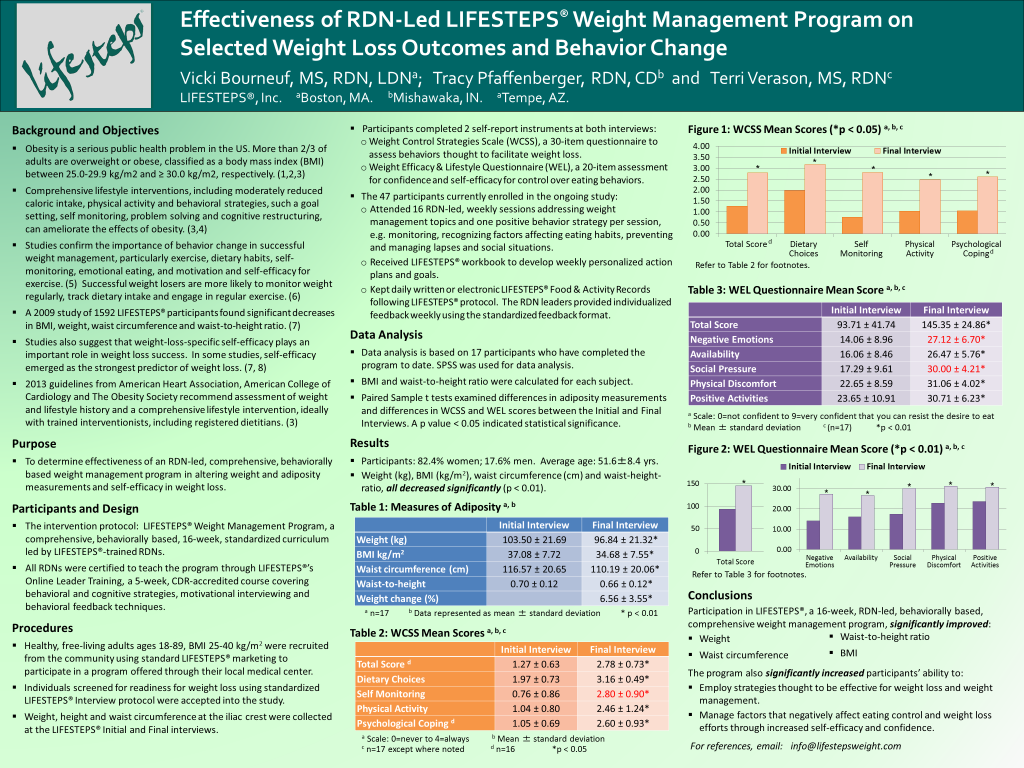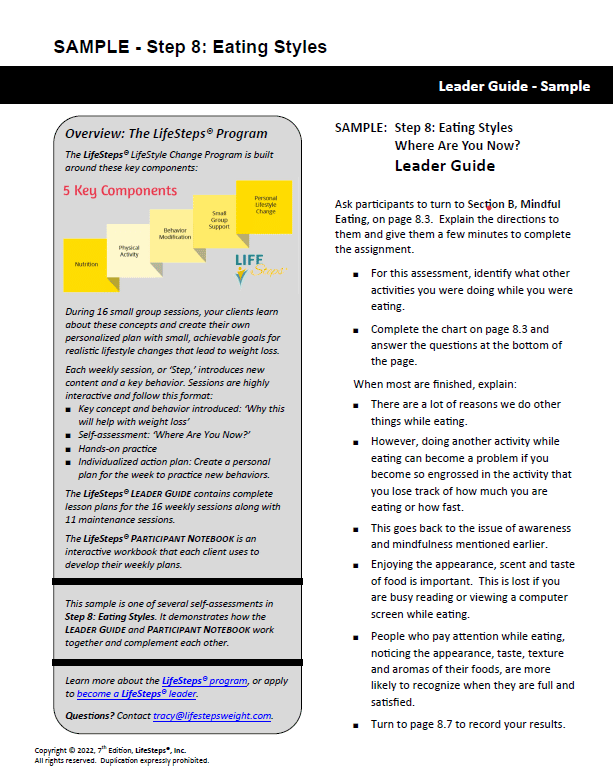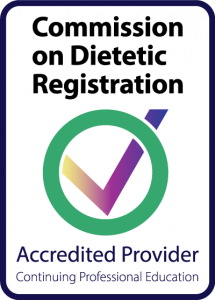Meets Guidelines
LifeSteps® is grounded in sound science and reflects current dietary, physical activity and weight management guidelines, including:
- The Dietary Guidelines for Americans 2020-2025
- 2013 AHA/ACC/TOS Guideline for the Management of Overweight and Obesity in Adults
- 2018 Physical Activity Guidelines for Americans
LifeSteps® also reflects the position of the American Diabetes Association for diabetes management and the Academy of Nutrition and Dietetics for weight management.
- American Diabetes Association’s Standards of Medical Care in Diabetes
- Academy of Nutrition and Dietetics Position on the Intervention and Treatment of Overweight and Obesity in Adults
Outcomes Studies
The LifeSteps® Team has been collecting outcomes data since 2003. Our data show that participants lose weight, lower their BMI and decrease their waist circumference. Below, find summaries of our studies, including our ongoing Mentored Outcomes Study.
LifeSteps® Data PUBLISHED!
Topics in Clinical Nutrition 2018
In early 2010, the LifeSteps® Management Team partnered with the nutrition faculty and an undergraduate student at Arizona State University to collect and analyze data for 1,592 participants enrolled in LifeSteps® programs in 13 different states. The study examined the effects of LifeSteps® on measures of adiposity (body weight, body mass index [BMI], waist circumference, and waist-to-height ratio), confidence and beliefs (weight management, physical activity), and lifestyle behaviors (dietary self-monitoring, fruit and vegetable consumption, physical activity).
Key outcomes included:
- 1,131 of the 1,592 participants (71%) completed the program indicating a low level of attrition.
- Body weight, BMI, waist circumference and waist-to-height ratio decreased significantly between initial and final assessments of the 1,131 participants completing the program.
- Three behaviors participants reported as most helpful for weight management were: Keep food records, do aerobic exercise and measure servings.
Abstracts were presented at the 2010 SCAN and FNCE conferences.
PDF of article in Topics in Clinical Nutrition
Survey Instrument and Data Collection
The cognitive component of the Outcomes Survey instrument was revised based on the results of a Pilot Study. The revised survey asked participants to rate:
- Their confidence level for managing their behavior in specific situations.
- The strength of their belief that specific eating and physical activity actions would lead to specific health benefits.
- The three strategies (from a list of 15) that were most helpful in their weight management endeavor.
Data collection using the new instrument started in January 2003 and continued through the spring of 2009. During this 6-year data collection period:
- 18 leaders provided pre- and post-treatment physical data on program participants, including age, height, weight and waist circumference.
- 754 participants provided complete physical and behavioral data.
- Some form of physical or behavioral data was obtained from 1,592 program participants.
Key Outcomes
- Significant (p<0.001) decrease in body weight, BMI, waist circumference and waist-to-height ratio.
- 1,131 of the 1,592 participants (71%) completed the program, indicating a low level of attrition.
- “Keep food records” was reported by 63.7% of those completing the outcome instrument as the most helpful program activity.
Trends
Statistical analysis could not be done on the food intake, physical activity, self-efficacy and belief data from the Outcomes Survey Instrument, but it was possible to look at the following trends:
Current Eating and Physical Activity Behaviors
- Improvements in food choices as demonstrated by increased of servings from the nutrient-rich food groups.
- Increased levels of physical activity post-treatment with greater gains in aerobic than resistance activity.
Confidence Measures
- The percentage of respondents with low confidence in specific eating and physical activity situations decreased from pre- to post-treatment for all situations. Ratings of “moderately confident” or “highly confident” increased for all eating situations.
- “High confidence” ratings increased for all physical activity situations.
- The percentage of respondents feeling “moderately confident” when family and friends are not physically active and when family and friends do not encourage physical activity decreased from pre- to post-treatment. However, the percentage of respondents feeling “highly confident” in these two situations increased considerably from pre- to post-treatment.
Strength of Beliefs
Respondents were also asked to rate the strength of their belief that changes in eating and/or physical activity would have a positive outcome in terms of reduced disease risk, weight maintenance and maintenance of new eating and/or physical activity behaviors.
- There were no major change from pre- to post-treatment. This is not surprising since belief in these outcomes probably prompted respondents to seek out a behavior change program such as LifeSteps® .
- The above is evidenced in relatively high ratings at pre-treatment with little change at post-treatment.
More detailed information on these trends can be found here. This is a detailed, tabulated chart of responses for each question of the Outcomes Survey.
WMDPG Mentored Outcomes Study - Ongoing
Data collection complete
In 2014, LifeSteps® was chosen to participate in a Mentored Outcomes Study with the Academy of Nutrition and Dietetics Weight Management Dietetic Practice Group (WMDPG). As a result of participating in this study, the LifeSteps® team has been collecting pre- and post-treatment data from several LifeSteps® programs around the country. To date, there are 117 subjects enrolled in the study, with complete data on 99 subjects.
Preliminary data was presented at the April, 2015 WMDPG Symposium in Portland, Oregon.
Results
Participation in LifeSteps®, a 16-week, RDN-led, behavior-based, comprehensive weight management program, significantly improved (p < 0.01) measures of adiposity:
- Weight
- BMI
- Waist circumference
- Waist-to-height ratio
The program also significantly increased participants’ ability to:
- Employ strategies thought to be effective for weight loss and weight management (p < 0.05).
- Manage factors that negatively affect eating control and weight loss efforts through increased self-efficacy and confidence (p < 0.01).
Click image below to see poster presented at the WMDPG Symposium, April, 2015.
Pilot Study
An outcomes measurement instrument developed by LifeSteps®, Inc. was tested by collecting data from individuals who participated in the LifeSteps® Weight Management Program between September 2000 and June 2001. The instrument was designed to collect information on current eating and physical activity behaviors. Participants were asked to rate the importance of following specific behavioral strategies taught in LifeSteps® and to rate their confidence in performing these behaviors. Eighteen LifeSteps® Leaders and 133 program participants participated in the pilot. Participant pre- and post-treatment weights were also provided by the leaders.
Results
-
Keeping Food Records:
- 50% of participants who did not record dietary intake prior to the program were keeping a food record at least 3-4 times per week post-treatment.
- 32% of participants were keeping a food record daily.
-
Weight Loss:
Averaged just under 1 pound per week.
-
Dietary Intake Changes:
Positive increases were reported from the Fruit, Vegetable, Grain and Dairy Groups:
- Fruit Group:
- 30% increased from 1 serving to 2-3 servings per day
- 33% maintained intake at 2-3 servings per day
- Vegetable Group:
- 23% increased intake from 1 serving to 2-3 servings per day
- 27% maintained intake at 2-3 servings per day
- Grain Group:
- 23% increased intake from 1-3 servings to 4-6 servings per day
- Dairy Group
- 13% increased intake from 1 serving to 3 servings per day
- 18% maintained intake at 3 servings per day
- 7% increased intake from 3 servings to 4 servings per day
- Others:
- A small decrease in servings of foods classified as “Others”, or foods high in fat or sugar, was reported.
- Fruit Group:
-
Physical Activity Changes:
Positive changes were observed in both aerobic activity and strength training.
- Aerobic Activity:
- 10% of respondents increased from none to 1-3 hours per week
- 16% increased from less than 30 minutes per week to 1-3 hours per week
- 6% increased from 30-60 minutes per week to 1-3 hours per week
- Strength Training:
- 10% increased from none to less than 30 minutes per week
- 9% increased from none to 30-60 minutes per week
- 5% increased to 1-3 hours per week
Post-treatment Maintenance:
To measure weight maintenance, a telephone survey was conducted 6-9 months post treatment. Of the 133 original participants in the pilot study, 94.7% (n=126) were reached by phone and asked to report their current weight. Results were classified into 3 groups:
- Losers were defined as those who continued to lose weight post treatment.
- Maintainers were defined as those maintained their end-of-treatment weight or gained < 5 pounds post treatment.
- Gainers were defined as those who had gained > 5 pounds post treatment.
Of the 126 surveyed 6-9 months after treatment:
- 92% were classified as losers (n=116)
- 4% were maintainers (n=7)
- 6% were gainers (n=3).
Historical Data
Fuller, E. et al. LIFESTEPS Versus Weighing the Options Criteria: An evaluation of a Nonclinical Weight Management Program. Nutrition Today, 1996. 31(5), 198-202.
LifeSteps® was originally developed by National Dairy Council® in 1985 as a worksite wellness program. It has been tested throughout the years, beginning with this study published in Nutrition Today in 1996. LifeSteps® has withstood the test of time and continues to help participants across the country make lasting behavior changes.


